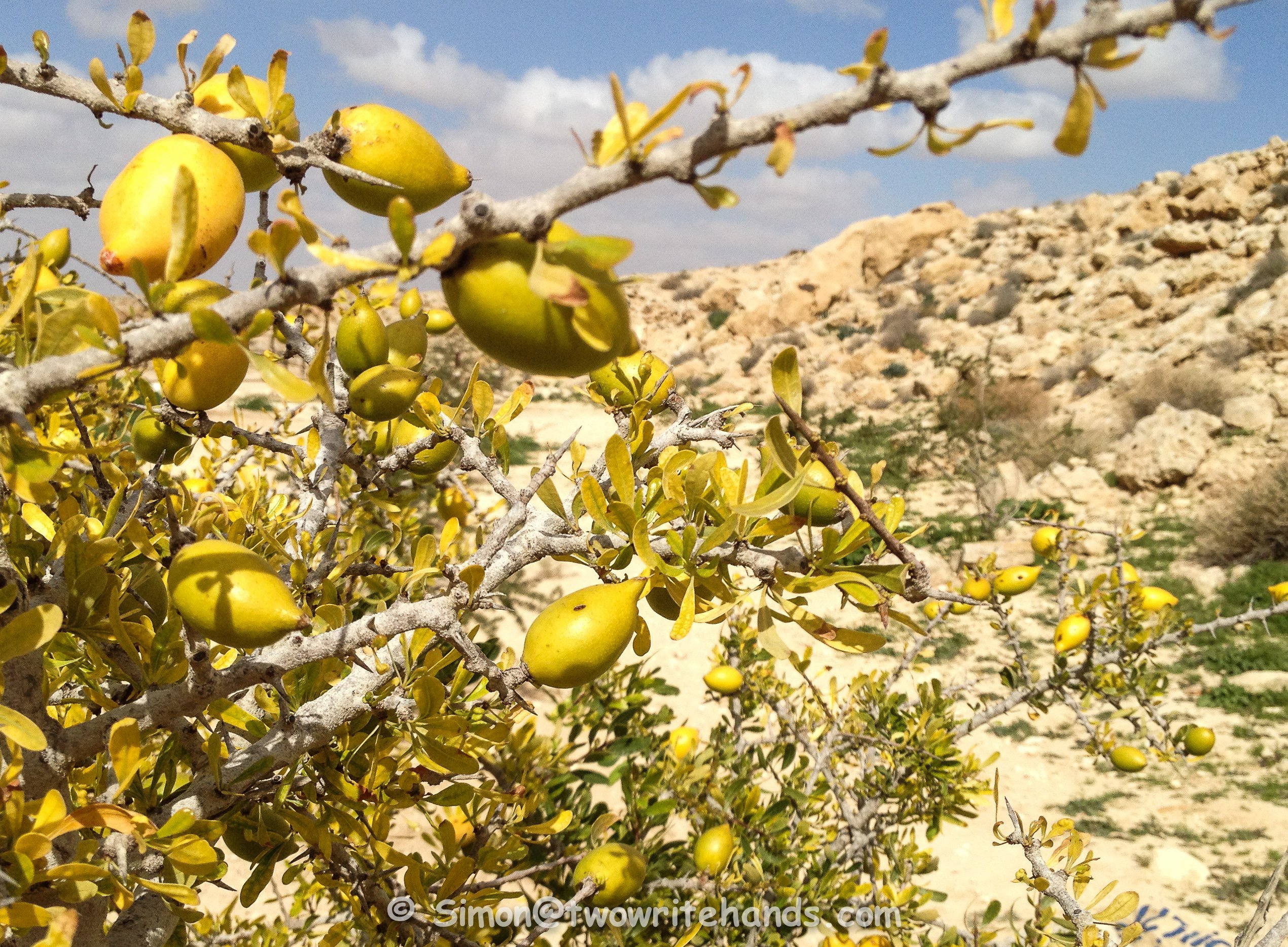From Their Birthplace in Morocco, These Amazing Trees Spread Their Precious Oil Around the Globe
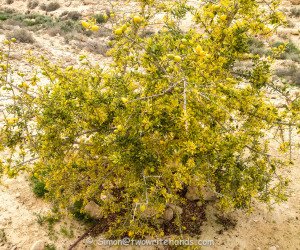
Young “Tree of Life”
Our first encounter with the argan tree (also known as tree of life) was in Israel’s Negev Desert, a long way from its origins in southwestern Morocco. The trees and the oil they produce turned out to be one of those unexpected WOW’s.
Simon, Otto and I were spending a week in Israel with my cousins, who made every day an adventure for us. On this particular day, they brought us into the Negev for our second view of the fascinating diversity of desert life, Israeli style.
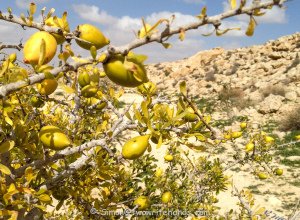
Argan Fruit Ready to Harvest
After witnessing several mini-WOW’s; a goat farm in close proximity to a military base, tiny shack-like houses with satellite dishes, a woman in traditional Muslim dress walking along the roadside talking on a cell phone, another woman riding a donkey wearing Crocs on her feet and several signs that warned of camels crossing the road, we thought there were no surprises left. We were wrong.
Our cousins brought us to Orlyya, a farm that grows not only argan trees, but a wide variety of herbs. Yoni, the owner of the property, welcomed us with his own blend of herbal tea and tiny Israeli cookies.
Thus refreshed, we followed Yoni as he proudly showed us around his farm,which had once been a barren wasteland. He told us that he had brought his argan trees from Morocco and planted them for their unique oil. The trees’ olive-shaped nuts are harvested and processed by hand. The result is an oil used as a culinary enhancement and in cosmetic products such as massage oil, soap, facial moisturizer and shampoo.
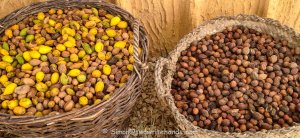
Argan Nuts with and Without the Pulp
All the work is done on the premises. First, the argan fruits are harvested, dried outdoors, and the pulp removed. Then the nuts are cracked in order to access the one to three oil-rich kernels inside. Kernels designated for culinary oil are roasted to enhance its pleasant nutty flavor. Those kernels destined for cosmetic products forgo the roasting to protect users from having to go around smelling like something yummy to eat.
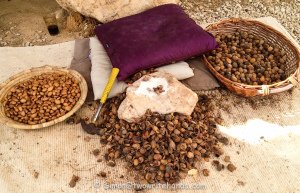
Argan Nuts being Cracked to Extract the Kernels
The oil is extracted by grinding and pressing the kernels into a brownish mush that yields pure, unfiltered oil. It is then decanted and allowed to settle for several days.
Nothing goes to waste. The flesh of the fruits and the press protein-rich cakes that are left after the oil has been extracted are used as feed for animals.
We were invited to sample the culinary oil, which is used for dipping bread, in salads and for drizzling over couscous, fish, meats and vegetables. The taste was slightly reminiscent of hazelnut, but not quite. The flavor and texture was deliciously luxurious.
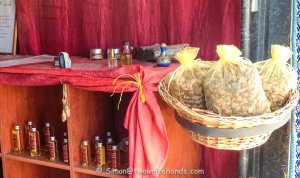
Argan Oil Ready for Sale
The lotion I rubbed into my hands was silky and rich. And no, it didn’t smell overpoweringly nutty.
Because every part of the process is painstakingly executed by hand, and it takes the fruit of an entire argan tree to produce one liter of oil, the products sold from farms like Yoni’s and online worldwide are on the expensive side. The small bottle of facial oil and bar of soap I purchased for my mother came to approximately $60.00. Of course, the quality is such that if you can afford it, you do get what you pay for.
Argan trees need little water, and can survive in the harsh climate of the Negev. Yoni’s trees were young, and approximately 6 feet in height. The more mature trees of Morocco have grown to a height of 30 feet or higher. Yoni will, however get plenty of bang for his bark, as argan trees have a life expectancy of 250 years.
The twisted, gnarled trunk of the argan tree makes it possible for goats to climb high enough to feast on the leaves and fruit. Remember the coffee bean eating/pooping civet cats I told you about in the Panamanian Paradise series post about Boquete coffee? Well the goats perform the same service. Once the intact nuts are excreted, they can be cracked and the kernels are removed. Have no fear, though. The combined efforts of the trees, goats and workers are not sold commercially.
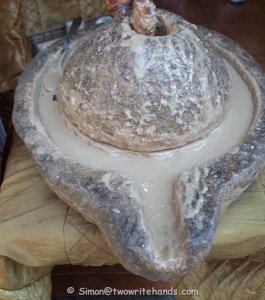
Argan Oil being Produced in Segovia, Spain
A little over a year after our visit to Israel, we saw the products from the argan tree in a small boutique as we were exploring Segovia, Spain (where the Roman aqueduct WOWed us). Simon noticed a women grinding and mashing argan nuts.
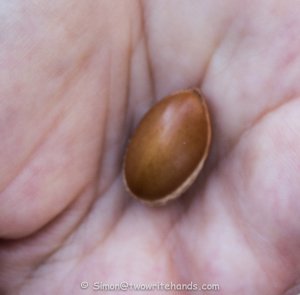
A Single Argan Nut Seen in Segovia, Spain
She had an impressive line-up of cosmetics to sell. Unfortunately, our pitiful Spanish wasn’t enough to communicate very effectively, but the experience was a delightful echo of a distant but unforgettable WOW.
Additional information on argan oil and Orlyya farm is available at http://argan.lanegev.co.il/infoen.html and http://www.orlyya.co.i
(Buyer beware: If the argan oil product you are lusting after is too cheap it probably is not genuine. Increasing demand for argan products has led to less-than-authentic knock-offs. Make sure that the label has only pure argan oil on its ingredients list. If it contains anything else, you might want to give it a pass. Also, if it has a strong fragrance of something other than nuts, it’s not the real deal either.)
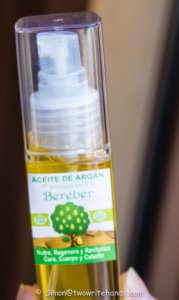
Argan Oil Found in Spain

